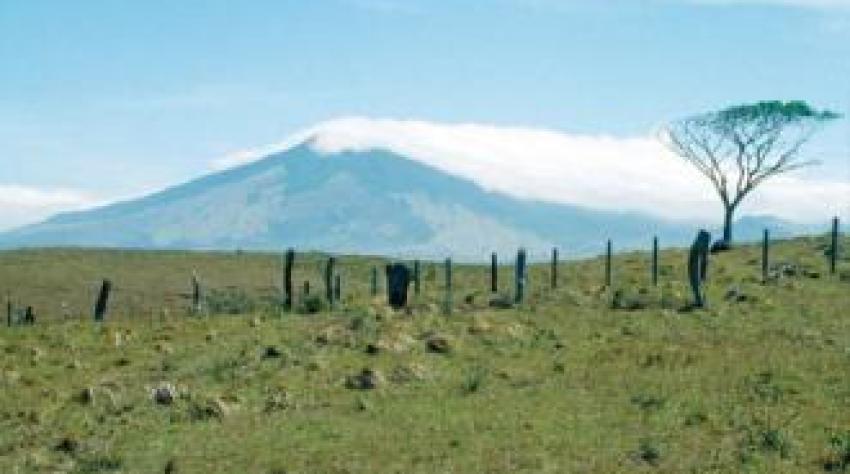December 2015, No. 3 Vol. LII, Sustainable Energy
When the first Climatescope report was published by the Multilateral Investment Fund (MIF) of the Inter-American Development Bank and Bloomberg New Energy Finance in 2012, it may have been surprising to many people that a Central American country ranked second among Latin American States in the index evaluating the investment climate for clean energy, yielding only to Brazil. Perhaps even more unexpected was the fact that it was Nicaragua, a country that only a decade before had the highest percentage of fossil fuel-based electricity generation in the region (almost 80 per cent). Also among the top 10 ranking countries were Panama (3rd), Costa Rica (8th) and Guatemala (9th).
These results reflect a very interesting development which has taken place in the region in the past decade: a deliberate reversal of the trend characterized by an ever-growing share of fossil fuels in the power generation mix. Meeting energy demands with fossil fuels became an increasingly heavy burden for the national and household economies of countries completely dependent on oil imports, especially when prices peaked in 2007-2008.
During the 1990s, after a decade of political turmoil and civil wars, Central American countries opened their energy sector to private participation in different degrees and modalities: from competitive wholesale markets in El Salvador, Guatemala, Nicaragua and Panama, to single-buyer systems in Costa Rica and Honduras. The motivations for this move were a combination of the need for new investments to satisfy growing energy demand, and the influence of international financial institutions adherent to the principles of the Washington Consensus.
The combination of cheap oil prices, regulatory frameworks encouraging short-term gain, absence of long-term policies, and risk-management considerations on the part of private investors, resulted in an increased use of petroleum derivatives for electricity production in all countries except Costa Rica, which maintained a strong focus on the development of renewable resources. For the region as a whole, participation of renewable sources in electricity generation decreased from 91 per cent in 1990 to less than 60 per cent in 2005. That year, petroleum-based power generation was the highest in Nicaragua (77 per cent) and Honduras (70 per cent). This situation backfired when international oil prices began to rise.
Faced with the impact of increasing oil prices in a heavily oil-dependent energy sector, Governments scrambled to respond with a number of disparate measures, not all of them sustainable—such as increased subsidies for energy consumption. However, partly due to regional collaboration efforts and aid from international organizations, by the mid-2000s, all countries had issued policy statements recognizing the need to increase the use of renewable energy sources and promote energy efficiency.
By the end of the decade, the results of those efforts started to show, and in 2014 renewables were the source of almost 64 per cent of the electricity generation in the region. The share of renewable sources in the electricity mix in Nicaragua went from 23 per cent in 2005 to 52 per cent in 2014, and from 46 to 70 per cent in Guatemala during the same period.
There have been impressive achievements, although not all countries have been equally successful, and there is still a long way to go to reach the region’s full potential for renewables, which is considered sufficient enough to meet all power sector needs (Dolezal, and others, 2013). A study entitled The Way Forward for Renewable Energy in Central America, published by the Worldwatch Institute in collaboration with INCAE Business School, pointed out the need to strengthen the investment climate, improve governance and administrative efficiency, and fill information gaps in order to succeed.
The study found four main areas of improvement in policy and finance to accelerate the move towards “sustainable energy systems based on renewable resources”:
- Mainstreaming renewable energy policies and goals among the diverse government agencies.
- Evaluating existing policy instruments related to renewables and, where necessary, refining the policy mix.
- Streamlining administrative processes for developing new renewable energy projects and making them less costly and time intensive.
- Establishing clear indicators for measuring, evaluating, and reporting progress on renewable energy policies and investment environments.
The report also identified four areas for improvement in knowledge and communication:
- Producing additional, detailed assessments of renewable resource potentials in the region and making them publicly available.
- Assessing renewable resource technical potentials against existing and future electricity load curves, and harvesting renewable resources in tandem with energy efficiency and smart grid solutions, via an integrated energy planning approach.
- Assessing and communicating widely the full socioeconomic impacts of different energy scenarios, including impacts on local economies and job creation.
- Increasing efforts to support national and regional renewable energy research; boosting public awareness of renewables; and strengthening the related knowledge and human resource capacities of the government, banking, and private industry sectors (Dolezal, and others, 2013, p. 12-13).
Work is underway in all of these areas, although not necessarily concerted and advancing at the same pace in all countries. Since the Worldwatch-INCAE report was published, utility-size commercial photovoltaic plants have been built in Guatemala and Honduras, wind-power generation has grown in Nicaragua and Panama, and the regulation for the distribution of photovoltaic panels for power generation has had positive developments in Guatemala, Panama, El Salvador and Costa Rica.
An important development in recent years is the integration of the Central American Regional Electricity Market regulatory framework, which provides the impetus for regional exchanges of electricity, as in the case of the Central American Electrical Interconnection System—a transmission line running from Guatemala to Panama. Transactions in the regional market doubled in just one year, from January 2013, when the definite market regulation started to apply, and have more than quadrupled since.
The regional market is allowing for a more efficient use of national power generation capacities, but the impact on the development of renewable energy resources is still not clear, since it will depend on the policies adopted by individual countries. For example, there is currently a discussion among energy policymakers and some investors regarding the introduction of natural gas, which requires a regional approach due to the size of necessary investments.
Whereas natural gas is considered by some as a cleaner and cheaper “transition fuel” to be used while renewable energy resources can be developed, others view it as a threat to small scale renewable energy projects which could not compete in an environment where prices define the policy. Whether the region can use natural gas to aid a transition to a cleaner energy mix, or whether it becomes stuck with investments tied to another imported fuel that can bring about future price shocks similar to those of petroleum will depend on the decisions made today.
Regardless of gaps and some setbacks, the recent tendencies in the power sector have demonstrated the capacity of Central American countries to develop national and regional policy responses and encourage private and public investment to address urgent energy sector issues. This experience can serve as a foundation for finding sustainable solutions to other important challenges, which are sometimes overlooked despite their proportions: energy poverty and energy use in the transportation sector.
Central American countries, especially those with the lowest electrification indices, such as Guatemala, Honduras and Nicaragua, have made important advances in providing access to electricity in the past two decades. Guatemala increased the percentage of households with electricity connection from 36 per cent in 1990 to almost 90 per cent in 2014, and all countries have surpassed the 80 per cent electrification mark. However, there are still several million Central Americans without access to electricity—a situation that requires solutions beyond the traditional grid extension.
It is also necessary to take into account that electricity represents between 6 and 22 per cent of total energy consumption in Central American countries (OLADE, 2014). For Guatemala and Nicaragua, the most important source of energy is biomass. Biomass consumption as proportion of total energy use is also high in Honduras and El Salvador.
Such a high use of biomass is an indicator of energy poverty, as most of it is in the form of fuelwood in the residential sector. According to a study published by the National Forest Institute of Guatemala (INAB), 98 per cent of the biomass used for energy purposes in the country is utilized for residential energy needs, and 70 per cent of households use fuelwood to meet their needs for cooking, heating and hot water (Larrañaga, and others, 2012).
It is well documented that the use of traditional technologies for biomass combustion has negative environmental, health and economic consequences, but until recently this issue has not received as much attention in national energy policies as the more “urban” concerns related to electricity and gasoline prices. There have been many attempts to contribute to a solution through the distribution of efficient wood-burning stoves, but none of them have been successful at the necessary scale.
A step in the right direction to address the failures of previous initiatives is Guatemala Country Action Plan for Clean Cookstoves and Fuels, which proposes a national goal of installing 65,000 efficient cookstoves a year. The goal is intended to be met with a market approach, promoting entrepreneurial activities of stove production and sale, microfinance for their purchase and increase demand through information provided to consumers. This effort is being led by the National Competitiveness Program, with the participation of government and private stakeholders, but it is still in the initial planning stages, and results are yet to be seen.
The other key challenge for all countries in the region is the transport sector, which uses approximately two thirds of petroleum derivatives. In 2013, petroleum comprised two thirds of total energy consumption in Panama, and more than 60 per cent in Costa Rica and El Salvador, mainly due to its use in both public and private transportation (OLADE, 2014).
The situation in the transport sector is more challenging than in the power sector, because solutions go beyond investing in the substitution of fuels or technologies. They require a system approach that entails coordination among numerous government agencies and, in many cases, different levels of government, as well as involvement of a greater number of stakeholders.
Meeting this challenge is not only a matter of environmental sustainability, but of competitiveness and quality of life for the people in Central America. There are many proposals and interesting initiatives, but some of them are rather isolated, and in many cases implementation is still lacking.
Central American countries need to bring together again the efforts of regional, national and international partners to promote the policy coherence, institutional coordination, capacities and investments necessary to address energy poverty and develop a cleaner transport sector. These factors are a key to achieving sustainability in all dimensions of energy production and use.
References
Dolezal, Adam, and others (2013). The Way Forward for Renewable Energy in Central America. Status Assessment, Best Practices, Gap Analysis. Washington D.C.: The Worldwatch Institute. Available from http://www.worldwatch.org/system/files/The%20Way%20Forward%20for%20Renewable%20Energy%20in%20Central%20America_low-res2.pdf.
Global Alliance for Clean Cookstoves (2014). Plan de Acción Nacional de Guatemala para Estufas y Combustibles Limpios. Guatemala City.
Larrañaga, Marcos Martín, and others (2012). Oferta y demanda de leña en la República de Guatemala. Guatemala: Instituto Nacional de Bosques de Guatemala (INAB).
Latin American Energy Organization (OLADE) (2014). Informe de Estadísticas Energéticas 2014. Quito, Ecuador.
United Nations, Economic Commission for Latin America and the Caribbean (2011). Centroamérica: Estadísticas del subsector eléctrico, 2010. LC/MEX/L.1039. Mexico, D.F.
United Nations, Economic Commission for Latin America and the Caribbean (2015). Centroamérica: Estadísticas de producción del subsector eléctrico, 2014. LC/MEX/L.1184. Mexico, D.F.
The UN Chronicle is not an official record. It is privileged to host senior United Nations officials as well as distinguished contributors from outside the United Nations system whose views are not necessarily those of the United Nations. Similarly, the boundaries and names shown, and the designations used, in maps or articles do not necessarily imply endorsement or acceptance by the United Nations.




